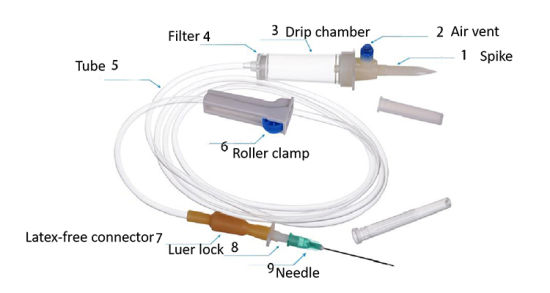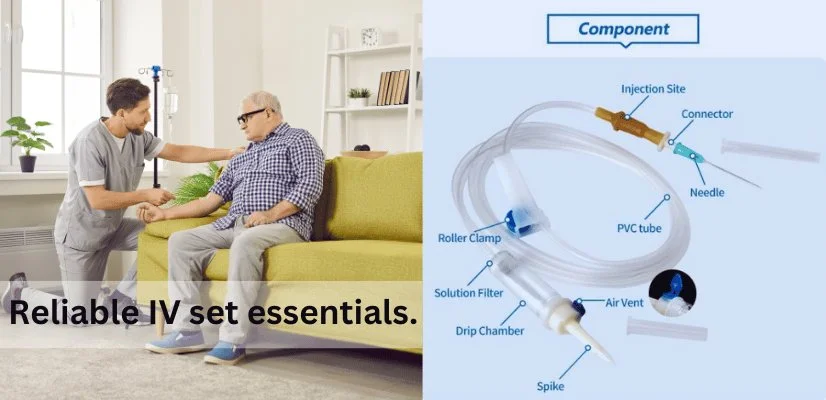Intravenous (IV) therapy is a crucial component of modern healthcare, delivering medications, fluids, and nutrients directly into the bloodstream. To ensure the safe and efficient administration of intravenous treatments, healthcare professionals rely on various IV set parts. These components, often taken for granted, play a significant role in the overall functionality and reliability of IV infusion systems. In this blog post, we will explore the different IV set parts, their functions, and their importance in delivering high-quality patient care.

-
IV Set Overview
Before delving into the specific parts of an IV set, it’s important to understand the overall structure and purpose of these devices. An IV set is a disposable, sterile, and single-use system that connects the medication or fluid container to the patient’s vascular access site. It typically consists of various components such as IV tubing, drip chambers, filters, injection ports, connectors, flow regulators, and needles or catheters.
-
IV Tubing
IV tubing forms the primary pathway through which medications and fluids flow from the IV bag to the patient’s bloodstream. Typically, manufacturers use transparent, flexible materials to make IV tubings, enabling easy monitoring of fluid levels and air bubble detection. The length and diameter of the tubing vary depending on the intended application. Moreover, designers ensure compatibility with different types of connectors and injection ports.
-
Drip Chambers
Drip chambers are small, cylindrical chambers located between the IV tubing and the patient’s access site. Their main function is to allow healthcare providers to visually monitor the flow rate of fluids and detect any air bubbles before they reach the patient. Drip chambers are usually made of transparent material, and they may incorporate additional features like filters or flow regulators.
-
IV Filters
IV filters are crucial for removing particulate matter, air bubbles, and contaminants from IV fluids prior to patient administration. They effectively prevent the infusion of harmful particles, reducing the risk of complications like embolism or infection. IV filters come in different types, including particulate filters, bacterial filters, and air elimination filters.
-
Injection Ports and Y-Sites
Injection ports and Y-sites are specialized components of an IV set that allow for the administration of additional medications or fluids without disrupting the primary infusion. Injection ports are small, self-sealing access points that healthcare professionals can use to introduce medications or draw blood samples. Y-sites connect two IV lines into a single line, allowing simultaneous administration of various fluids or medications.
-
Connectors are iv set parts
Connectors are integral parts of an IV set that facilitate the secure attachment of different components, such as tubing, filters, and injection ports. They ensure a tight seal and prevent leakage, reducing the risk of contamination and medication errors. Connectors, such as luer connectors, needle-free connectors, and screw connectors, come in various designs. Each design offers specific advantages and compatibility with different devices.
-
Flow Regulators of iv set parts
Flow regulators are mechanisms that control the rate of fluid administration, allowing healthcare providers to precisely adjust the flow according to the patient’s needs. They help maintain a consistent and controlled infusion rate, preventing over- or under-infusion situations. Flow regulators come in two types: manual and automatic. They might include extra features such as flow control buttons or flow rate indicators.
-
Needles and Catheters (iv set parts)
Needles and catheters are essential components for gaining vascular access and delivering medications or fluids directly into the patient’s bloodstream. Healthcare professionals use needles for initial venipuncture. They then advance catheters through the needle into the vein and secure them in place. These components vary in size and type, meeting specific clinical needs. Examples include peripheral catheters, central venous catheters, and arterial catheters.
Conclusion
Healthcare professionals involved in administering intravenous therapy must understand the various parts of an IV set crucially. Each component serves a specific purpose in ensuring the safe and effective delivery of medications and fluids. Healthcare providers improve patient care and minimize risks associated with intravenous treatments by understanding the functions and importance of IV set components. These parts include tubing, drip chambers, filters, injection ports, connectors, flow regulators, needles, and catheters.
By prioritizing the selection and proper use of iv set parts, healthcare professionals contribute to the overall success of iv set parts therapy and enhance patient outcomes.
Disclaimer
The information provided is for general knowledge only. Consult your doctor for personalized advice and treatment. Medikart HealthCare is not liable for any actions taken based on this info.

